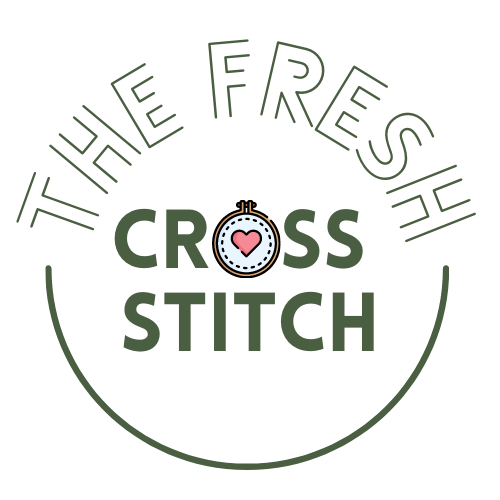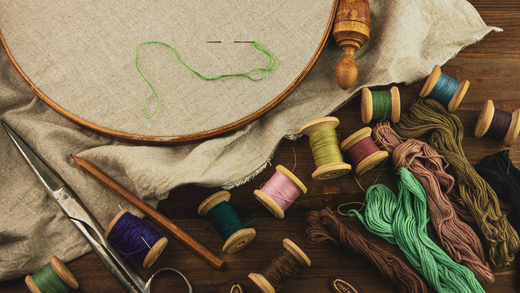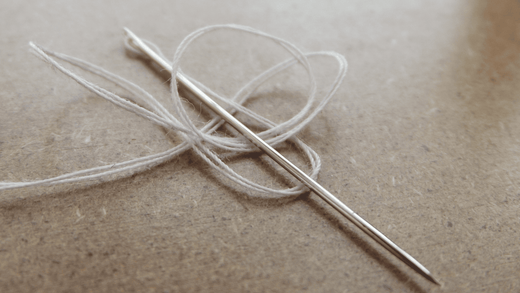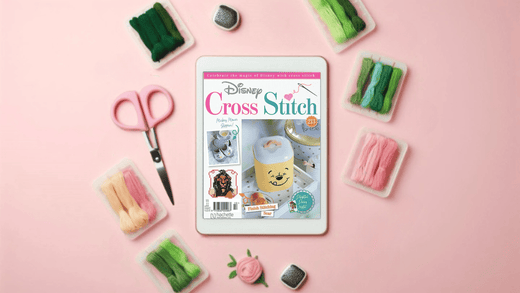Cross stitching is a delightful and rewarding hobby that allows you to create beautiful, intricate designs using just a needle, thread, and fabric. Whether you're a beginner or looking to refresh your supplies, having the right tools can make all the difference in your stitching journey. Being strict, you only need these 3 tools to start your cross-stitch journey. However, there are optional tools that ease the activity, so I have compiled the 10 tools you need to start cross stitching:
1. Embroidery Floss
Embroidery floss is the most basic material you'll need for cross stitching. Embroidery floss comes in a wide array of colors and is typically made from cotton or silk. It's used to create the stitches that form your design.
You will find tons of different floss brands, with DMC and Anchor being the most popular ones. The reasons for their popularity is their durability, bright colors, large color options, and their softness. It’s difficult to answer the question of what’s the best thread for cross stitching, since this is a matter of personal preference. You can go for one of these brands, or just go for a cheaper option if you’re starting in cross stitch and don’t want to invest much in it! It 's up to you! Just bear in mind most cross-stitch patterns include a color guide in DMC colors. However, if you prefer to use the Anchor brand, you can use a DMC to Anchor conversion chart to find an equivalent color.
Where to buy embroidery floss?
Embroidery floss can be found in most craft stores, but you can also purchase it online from retailers like Amazon or specialty needlework shops. I recommend you to check several stores and check for sales or bulk discounts to save money on larger projects. In the long term, you will need a certain amount of colors, so buying your threads at a good price point will make you save some good money.
2. Cross-stitch fabric
There are several types of cross-stitch fabrics, and Aida cloth is one the most popular options. This fabric is specially woven with evenly spaced holes or squares, making it easy to create uniform stitches. Aida cloth comes in various counts, which refer to the number of stitches per inch. Beginners often start with larger Aida counts, but you can experiment with different counts to achieve different levels of detail.
Choosing the right cross-stitch fabric is easier than it sounds at first sight. You can learn more about the types of cross-stitch fabrics and how counts work by reading my blog articles, and you’ll realize it’s really quite simple!
Where to buy cross-stitch fabric?
Aida cloth is readily available at craft stores and online retailers that specialize in needlework supplies. Websites like Etsy also offer a wide selection of Aida cloth in various colors and counts, often from independent sellers.
3. Embroidery Needles
Choose needles that are specifically designed for embroidery or cross stitching. These needles have a larger eye to accommodate multiple strands of embroidery floss and a blunt tip to prevent snagging the fabric.
Where to buy embroidery needles?
Embroidery needles can be purchased at any craft store, as well as online. Look for a variety pack that includes different sizes to accommodate various fabric and thread thicknesses or check my cross-stitch needle guide to find out what you need to step up your embroidery game.
4. Embroidery Hoop
Hoops and frames are used to keep your fabric taut while stitching, which helps ensure even stitches and prevents puckering. Hoops come in various sizes and materials, such as wood or plastic. Choose one that comfortably fits the size of your project.
This tool is not strictly necessary to start cross stitching, but once you try you won’t go back. Keeping the fabric at the right tension makes the process so much easier — you will see the holes more clearly, the needle will move with ease, and you will have less trouble with the threads making knots in the backside. Plus, this is an economic tool that will last forever, so it’s definitely with buying.
Where to buy embroidery hoops?
Hoops and frames are commonly sold at craft stores, but you can also find them online from specialty needlework shops. You will also find personalized embroidery hoops in handmade stores such as Etsy. Whatever you choose, consider investing in a high-quality wooden hoop (rather than plastic) that will last for many projects to come.
5. Scissors
A good pair of embroidery scissors is essential for cutting your embroidery floss neatly and accurately. Look for sharp, precision scissors with a pointed tip for precise cutting.
Where to buy scissors?
Embroidery scissors are widely available at craft stores, sewing supply shops, and online retailers. Look for a pair with a comfortable grip and sharp blades for precise cutting.
6. Cross-Stitch Patterns
Whether you're following a pattern from a book, magazine, or digital download, having a clear pattern to reference is crucial for cross stitching. Beginners may find it helpful to start with simple patterns before tackling more complex designs. With time, you might be able to create your own designs, but if you’re starting with cross stitch you will feel more comfortable by following a pattern.
If you’re completely new, you might want to check my blog article on how to read a cross-stitch pattern, and what’s the right order to cross stitching. Even though cross stitch is a no brainer, it doesn’t hurt to learn the theory first!
Where to buy cross-stitch patterns?
Patterns can be found in books, magazines, and online marketplaces like Etsy or Craftsy. Many websites, like The Fresh Cross Stitch, also offer free or inexpensive downloadable cross-stitch patterns for personal use. Additionally, consider joining online communities or forums where fellow stitchers share patterns and tips.
7. Good lightning
Essential, and often overlooked. Adequate lighting is essential for cross stitching, as it helps prevent eye strain and ensures accurate stitching. Natural daylight is ideal, but if you're stitching in the evening or in a room with limited natural light, invest in a good quality lamp with adjustable brightness and color temperature. Look for lamps specifically designed for crafting or needlework, which often feature adjustable arms and built-in magnifiers to help you see intricate details more clearly. Position your lamp so that it illuminates your work area evenly, avoiding glare or shadows that could make stitching difficult. With proper lighting, you'll be able to stitch comfortably for longer periods and enjoy your projects with greater ease and precision.
Where to buy a cross-stitch lamp?
Cross-stitch lamps, tailored for optimal needlework illumination, can be sourced from various retailers, both online and in-store. Online marketplaces like Amazon, eBay, and Etsy offer extensive options from various sellers. Additionally, specialty needlework shops may carry curated collections, while office supply stores often provide task lighting solutions suitable for cross stitching. Joining online crafting communities can also yield valuable recommendations from fellow stitchers. When selecting a lamp, prioritize features like brightness, color temperature adjustability, and size to ensure it complements your stitching setup and enhances your overall experience.
8. Organizational Tools
Keeping your embroidery floss organized can save you time and frustration. With time, you will see you accumulate different thread colors, and it might be frustrating finding the right one and keeping them in good condition.
Consider investing in a sewing box, a floss organizer, or a storage box to keep your threads neatly sorted and easily accessible.
Where to buy an organization box for cross stitch?
Organization boxes for cross-stitch supplies are available at various retailers, including your local craft stores, and online marketplaces like Amazon or Etsy, offering a wide selection with different sizes and styles to choose from.
Also, keep in mind you don’t necessarily need to buy an item for this purpose. Giving the classic box of cookies or chocolates a second life might do the trick! Just give it a thought, select an object, and set it aside for organization.
9. Needle Minder
A needle minder is a handy tool that keeps track of your needle when not in use. It consists of a magnet that keeps your needle in place when you’re not using it. While this is not an essential tool, it will make your cross-stitch journey easier. Take it from an experienced cross stitcher — you will find yourself looking for a lost needle on a daily basis, and you will lose count of the needles you never find.
Where to buy a needle minder?
You can find needle minders in any craft store or sewing store, but in my personal experience, you will find the prettiest ones on Etsy. This marketplace is full of handmade needle minders with immensely creative designs for every cross stitcher.
10. Needle Threader
Threaders are handy tools that help you thread your needle quickly and easily, especially if you're working with multiple strands of embroidery floss. Is this mandatory? Absolutely not, but threading your needle may be frustrating if you’re new to embroidery or sewing. Consider investing in a threader that helps you skip this annoying step, and you’ll have a more pleasant cross-stitch journey.
Where to buy a needle threader?
In order to find this type of accessories, I recommend you to visit your local store or especially craft stores (online or offline). Specialty sewing supply shops may also carry high-quality needle threaders, often alongside other sewing accessories. Whether you prefer to shop in person or online, you can easily find a needle threader that suits your needs and helps streamline your stitching process.


















